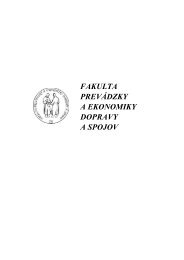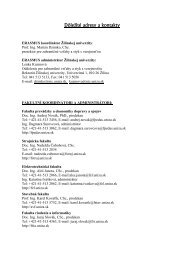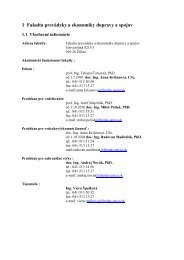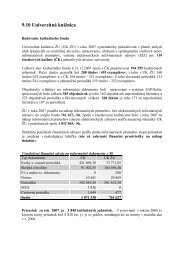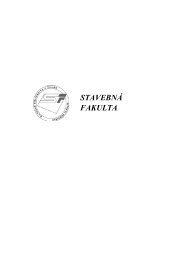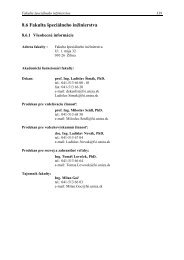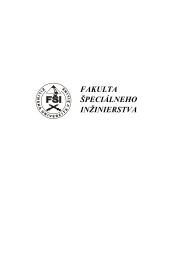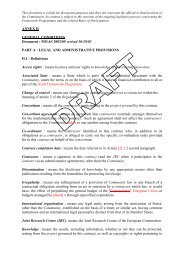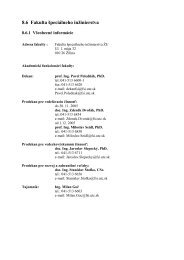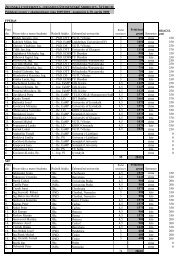posudzovanie vplyvu automobilovej dopravy na - Žilinská univerzita
posudzovanie vplyvu automobilovej dopravy na - Žilinská univerzita
posudzovanie vplyvu automobilovej dopravy na - Žilinská univerzita
You also want an ePaper? Increase the reach of your titles
YUMPU automatically turns print PDFs into web optimized ePapers that Google loves.
C O M M U N I C A T I O N S<br />
I S<br />
nice trate všetky hodnoty diferencií geometrie profilov <strong>na</strong> dĺžke<br />
zvoleného intervalu horizontálnej súradnice priečneho rezu ľavej<br />
koľajnice. Farebná škála pomáha určiť oblasti od minimálnych až<br />
po maximálne diferencie geometrie <strong>na</strong> trati a <strong>na</strong> základe farebných<br />
plôch určuje celkový stav, prípadne zmenu stavu vyhodnocovanú<br />
po určitom čase.<br />
R Area (): Plocha určená priebehom diferenčnej krivky<br />
a nulovou horizontálnou súradnicou – oblasť menšej vertikálnej<br />
súradnice meraného profilu, oproti referenčnému profilu (opotrebenie),<br />
<strong>na</strong> pravej koľajnici.<br />
R Area (): Plocha určená priebehom diferenčnej krivky<br />
a nulovou horizontálnou súradnicou – oblasť väčšej vertikálnej<br />
súradnice meraného profilu, oproti referenčnému profilu (návalok),<br />
<strong>na</strong> pravej koľajnici.<br />
L Area (): Plocha určená priebehom diferenčnej krivky<br />
a nulovou horizontálnou súradnicou – oblasť menšej vertikálnej<br />
súradnice meraného profilu, oproti referenčnému profilu (opotrebenie),<br />
<strong>na</strong> ľavej koľajnici.<br />
L Area (): Plocha určená priebehom diferenčnej krivky<br />
a nulovou horizontálnou súradnicou – oblasť väčšej vertikálnej<br />
súradnice meraného profilu, oproti referenčnému profilu (návalok),<br />
<strong>na</strong> ľavej koľajnici.<br />
Radii: Definícia trate pomocou polomerov oblúkov. Priamu<br />
trať predstavuje horizontál<strong>na</strong> súradnicová os, hodnota parametra<br />
v grafe má oz<strong>na</strong>čenie G.<br />
<strong>na</strong>te value in the selected track interval length of the horizontal<br />
coordi<strong>na</strong>te of the cross section of the left rail. The color scale helps<br />
to locate the areas from maximum to minimum geometry difference<br />
along the track and on the base of colored areas it is possible<br />
to evaluate the overall rail state or the change of the rail state<br />
under operation after some time.<br />
R Area (): The area determined by the course of the difference<br />
curve and by zero horizontal coordi<strong>na</strong>te line – area of the<br />
lower value of the measured profile vertical coordi<strong>na</strong>te against reference<br />
profile (wearing) of the right rail.<br />
R Area (): The area determined by the course of the difference<br />
curve and by zero horizontal coordi<strong>na</strong>te line – area of the<br />
higher value of the measured profile vertical coordi<strong>na</strong>te against<br />
reference profile (adding) of the right rail.<br />
L Area (): The area determined by the course of the difference<br />
curve and by zero horizontal coordi<strong>na</strong>te line – area of the<br />
lower value of the measured profile vertical coordi<strong>na</strong>te against reference<br />
profile (wearing) of the left rail.<br />
L Area (): The area determined by the course of the difference<br />
curve and by zero horizontal coordi<strong>na</strong>te line – area of the higher<br />
value of the measured profile vertical coordi<strong>na</strong>te against reference<br />
profile (adding) of the left rail.<br />
Radii: Definition of the railway track with the help of curves<br />
radii. The straight track is shown by the horizontal coordi<strong>na</strong>te<br />
axis, parameter value in the diagram is labeled G.<br />
8. Záver<br />
Opotrebenie koľajníc predstavuje závažný problém prevádzky<br />
koľajových vozidiel. Negatívne dôsledky prílišného opotrebenia<br />
koľajníc sa prejavujú tak <strong>na</strong> zvýšenom zaťažení životného prostredia<br />
od materiálu rozptýleného do prostredia, parazitných kmitaní<br />
častí vozidiel, zvýšenej hladine hluku, tak <strong>na</strong> spôsobe jazdy železničného<br />
vozidla. Opotrebená koľaj rozhodujúcim spôsobom ovplyvňuje<br />
plynulý chod vozidiel, znižuje komfort jazdy, ako aj mieru<br />
bezpečnosti proti vykoľajeniu.<br />
Nízka kvalita železničnej trate spôsobuje vyšší koeficient poruchovosti<br />
prevádzky vozidiel a problémy s dopravou osôb a prepravou<br />
materiálu.<br />
8. Conclusion<br />
Wearing of the rail is important problem of the rail vehicles<br />
operation. Negative consequences of the extreme wearing of the<br />
rail can be demonstrated both on the loading of the environment<br />
from the material dispersed into the environment, parasite vibration<br />
of the parts of railway vehicles, high noise level and the manner of<br />
the railway vehicle runnig quality. The worn rail profile influences<br />
on a crucial manner smooth running of vehicles, decreases running<br />
comfort and safety against derailment too.<br />
The low quality track cases the higher failure coefficient of<br />
vehicles and problems with passengers and freight transportation.<br />
Literatúra – Reference:<br />
[1] UIC CODE 519 OR: Method for determining the equivalent conicity, Inter<strong>na</strong>tio<strong>na</strong>l Union of Railways, Draft of December 2001.<br />
[2] STN 73 6360: Geometrická poloha a usporiadanie koľaje železničných dráh normálneho rozchodu, September 2000.<br />
KOMUNIKÁCIE / COMMUNICATIONS 1/2003 ●<br />
51



